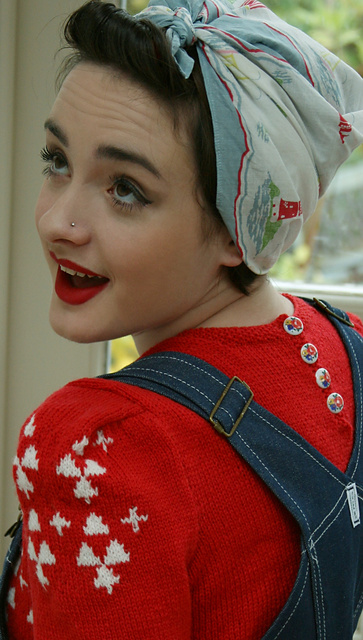Technical Bits: Fair Isle
In last week's post about The Perfect Christmas Jumper, I mentioned that the techniques used to make the beautiful colourwork were a combination of Fair Isle knitting and Intarsia. But what does this mean, and is it as scary as some would have you believe? Well I can tell you, not at all. In the first of two posts, I will give an explaination and some tips for using both techniques. First up is Fair Isle.
Also commonly known as standed knitting, Fair Isle is named after the traditional knitting of the Shetland Isles, this two-coloured standed knitting being particularly known to be practiced in Fair Isle. While traditionally, only two colours were used in any one row, today multicolour motifs are sometimes incorporated too.
The technique used to make the pattern is as follows: as you knit across the row, you use two balls of wool and knit with the one needed for that part of the pattern, while carrying the other across the back of the work. Really, that's it.
A particular characteristic of Fair Isle knitting is the use of small patterns that are repeated right across the work. The patterns for Fair Isle are charted, and thus are easy to follow as you can see exactly where to change colours. Using written-only instructions for stranded knitting can be very difficult to follow.
There are a few things to remember when knitting in Fair Isle:
Elegant Coat Gloves: Ravelry link and Knitonthenet Shop link to the pattern
The Perfect Christmas Jumper: Ravelry link and Knitonthenet Shop link to the pattern
Fair Isle Yoke: Ravelry link and Knitonthenet Shop link to A Stitch in Time Vol 1
Hearts and Bunnies Cardigan: Ravelry link and Knitonthenet Shop link to Vintage Gifts to Knit
Look out for next week's Technical Bits post about Intarsia and let us know in the comments if you're knitting anything using Fair Isle.
Ingrid x
Also commonly known as standed knitting, Fair Isle is named after the traditional knitting of the Shetland Isles, this two-coloured standed knitting being particularly known to be practiced in Fair Isle. While traditionally, only two colours were used in any one row, today multicolour motifs are sometimes incorporated too.
The technique used to make the pattern is as follows: as you knit across the row, you use two balls of wool and knit with the one needed for that part of the pattern, while carrying the other across the back of the work. Really, that's it.
A particular characteristic of Fair Isle knitting is the use of small patterns that are repeated right across the work. The patterns for Fair Isle are charted, and thus are easy to follow as you can see exactly where to change colours. Using written-only instructions for stranded knitting can be very difficult to follow.
There are a few things to remember when knitting in Fair Isle:
- More yarn is required in comparison to a normal garment of the same size because of the floats (strands carried across the back)
- Fair Isle makes a thick, warm fabric which is double layered, again due to the floats
- If you use a thick yarn it may become rather uncomfortable to wear, so many patterns are written for 4ply (fingering) weight yarns
- In stranded knitting the pattern is seen only on the Right Side of the work, the Wrong Side shows only the floats
- Try to keep an even tension with your floats, so they don't pull the work tight
- Try not to have very long floats as these can catch
- It's a little more technical than knitting in stripes, but not too much
- The end result will look wonderful!
Elegant Coat Gloves: Ravelry link and Knitonthenet Shop link to the pattern
The Perfect Christmas Jumper: Ravelry link and Knitonthenet Shop link to the pattern
Fair Isle Yoke: Ravelry link and Knitonthenet Shop link to A Stitch in Time Vol 1
Hearts and Bunnies Cardigan: Ravelry link and Knitonthenet Shop link to Vintage Gifts to Knit
Look out for next week's Technical Bits post about Intarsia and let us know in the comments if you're knitting anything using Fair Isle.
Ingrid x









2 Comments:
love technical posts! And I'm so intimidated by Fair Isle, but those gloves... I've been pondering them for a year, since last year's Christmas download. Maybe I'll work up the guts this year.
Yeah! Go for it :)
Glad to hear that you find the technical posts useful too.
Post a Comment
<< Home